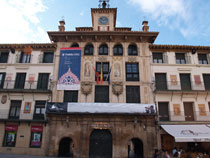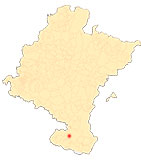place Nueva de Tudela
By Esther Elizalde
Clock House
Centred on the west flank, the "Casa del Reloj" or "Casa de la Ciudad" stands out in height, used by the old councillors to watch the bullfights, known for this reason as the "Balcón de Toros" (Bullfighting Balcony). It was built by Domingo Ucazcal himself and the master architect and sculptor Pedro Viñés, who was commissioned to do the carpentry of the building. Thus, the "Casa del Reloj" is a large rectangular building with three floors: the lower floor is made of stone and has a triple entrance arch, the first floor has three balconies with a ledge and ironwork, the second floor has three balconies without a ledge and, as a finishing touch, a gallery of round arches crowned by a wooden eave. Subsequently, different decorative motifs were added to make up the Casa del Reloj (Clock House) as we know it today. In the year of its construction, Building, two coats of arms of the city were added with explanatory cards executed by the master gilder Francisco Arregui. Later, in 1859, José Base and Patricio Andrés carried out the neoclassical painting that covers the entire surface and which, well into the 20th century, was restored by Lozano de Sotés. And as a final adornment, the neoclassical pavilion was built to house the Tower Clock, inaugurated in April 1885.
MARTÍNEZ ESCALADA, J.: La historia de Tudela contada por sus calles, Zaragoza, 1999.
GARCÍA GAINZA, M.C., HEREDIA MORENO, M.C., RIVAS CARMONA, J. and ORBE SIVATTE, M.: Catalog Monumental de Navarra. I. Merindad de Tudela, Pamplona, Institución Príncipe de Viana, 1980.
Catalog of the exhibition 120th anniversary of Tudela (802-2002): La cultura en Tudela a lo largo de su historia, Tudela, 2002.
A.A.V.V.: Ibaiak eta Haranak. guide del patrimonio artístico y paisajístico. Vol. VIII. Navarra, San Sebastián, Etor, 1991.
YANGUAS Y MIRANDA, J.: Diccionario histórico-político de Tudela, Zaragoza, 1828.
SAINZ PEREZ DE LABORDA, M.: Apuntes tudelanos, Tudela, 1969.
TARIFA CASTILLA, Mª.J.: La arquitectura religiosa del siglo XVI en la Merindad de Tudela, Pamplona, Gobierno de Navarra, department de Education y Cultura, Institución Príncipe de Viana, 2005.












